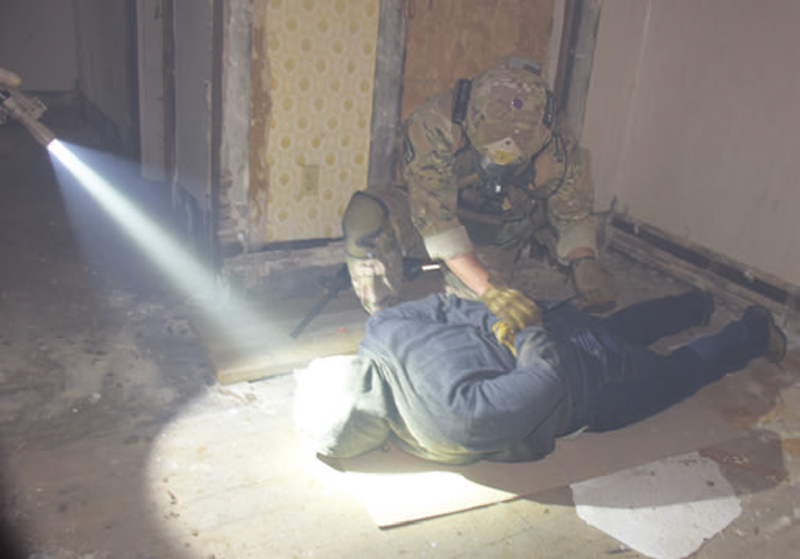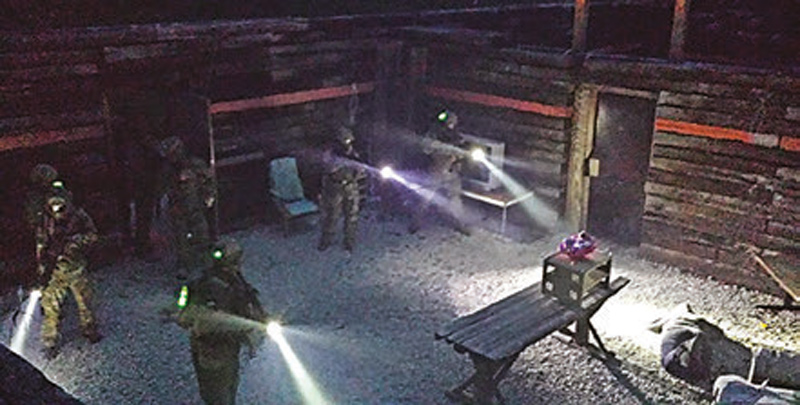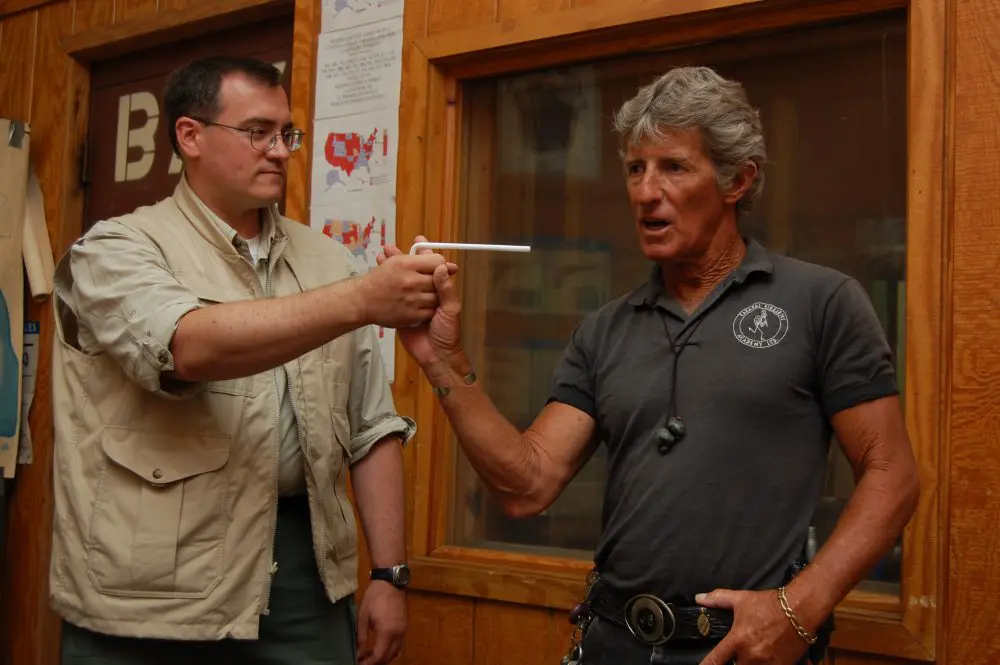COPS have—for cause—a dislike/distrust of lawyers. But they are inexorably tied to them for their entire career. Many (most?) cops consider that the criminal justice system has nothing to do with either criminals or justice, and is a system that is a self-licking ice-cream cone for the assorted lawyers so employed.
Prosecutors are the people who give cops grief about their paperwork, their performance on the stand, and their attitude. Prosecutors are also the ones who knock down those felony collars to Attempted Possession of an Unloaded Firearm— a violation in the Underwear Code.
Cops have a tendency to see lawyers as stuffy 40-pound brains who might have a fine grasp of the law but are clueless as to the application of it on the street. Most lawyers, especially those who are prosecutors, consider cops to be uncouth brutes who are unable to do arrest-related paperwork properly or articulate their actions when on the stand. Having said that, they are drawn to each other, as they must be able to function if the good people are to prevail.
My company, EAG Tactical, does a lot of training at the Alliance, Ohio Police Department training facility. Physically it is an excellent place, with square ranges out to 300 meters, a shoot house and a live-fire aircraft simulator. More importantly, the Powers That Be are not only heads up about their own training, but their facility has also become a regular stop for other less fortunate city, state and federal agencies. A very important feature is that they accept vetted civilians to train there, something seldom seen in other jurisdictions.

Table of Contents
TWO POINTS OF VIEW
This article is different from any other I have written, in that I have a co-author: Jennifer Arnold, City Prosecutor for the city of Alliance, Ohio. I’ll paint a picture of what we did, and Jen will write about her experience and how it helps in the pursuit of justice. Jen’s comments are in italics.
This past May we were starting a shoot house class at the Alliance PD when we were notified that the ERT students in the class would be doing a real-world warrant service that afternoon. I was asked if I wanted to observe the hit (LemmethinkaboutthatOK!). I sat in on the target brief, and a female not in uniform introduced herself to me—Jennifer Arnold, the City Prosecutor.
As the prosecutor, I am eventually answering for what happens on the street. I know most officers don’t understand that, but being the prosecutor in a small town means I am also your legal counsel (that’s right, the one you call when the crap hits the fan).
All cases (felony and misdemeanor), with very few exceptions, originate in my office. I learned from my predecessor that it is better to be informed and involved rather than playing catch up. That does not mean that I interfere in the process, but since all search warrants have to be approved by me (or my office), it’s easy to stay in the loop. I do not regularly go out on warrant executions, but if I think there is a specific need, APD welcomes my presence. This was how I met Pat.
After the warrant was executed, Jen told me that she understood what her job was and what the cop’s job was, but that she didn’t know what transpired in the house during the service of a warrant.
Fortuitously, we were in the middle of the second of three consecutive shoot house classes. The third class, Continuing Education Course (CEC), is an advanced class that utilizes team tactics with both live-fire and UTM Man Marker rounds.






USE OF ROLE PLAYERS
We utilize Role Players (RP) in the UTM scenarios, casting them as armed bad guys, unknowns, and bystanders. We include prisoner handling, Sensitive Site Exploitation (SSE) and other Tactics, Techniques and Procedures (TTPs) in these scenarios as well. Our RPs run the gamut from average Earth people (OK, above average), to cops, Feds and Mil. The RPs are an integral part of the team. They have to subjugate their egos and desire to win in order to present a realistic iteration.
Too often we see people turn good training into an unwinnable game, and what should have been viable training is flushed down the porcelain receptacle—something we try to avoid. We provide the RPs with a script that gives them some latitude. For example, if the team does everything correctly and does not give the RP a chance to engage, he can comply.
Conversely, if the team does not do it right, the RP can engage, but not all RPs are armed. They are instructed—scenario dependent—to comply, not comply, make a lot of noise, and so on. We use an RP Operational Controller (RPOC) to manage the assets correctly. In this way we can design scenarios that will test specific TTPs. Each scenario and part thereof has a learning objective, and the RPOC ensures that learning occurs.
The wheels started turning, and I offered Jen the opportunity to be an RP on a day/night when we would be doing both on- and off-campus exercises. After some detailed explanation of what we would be doing, she and her assistant, Christine Marie, volunteered to be RPs. On this training day, our evening scenarios started with two hits off campus in an abandoned two-story house. The team was looking for specific bad guys from the Mongolian Irish Liberation Front (MILF).
Jen and Christine would be unarmed unknowns. Their orders were to reluctantly cooperate but to make a lot of noise and argue—much as most do in real life. The team would use Deadly Physical Force only against those using/about to use DPF against them. Prisoners would be controlled, searched, removed to the trailers and searched again.
ON SCENE
In each case, the entry team banged the room prior to entry, engaged the bad guys, controlled everyone in the house, cuffed, frisked and interrogated the living. In each case, Jennifer and Christine played their roles to a T—cooperating, but sullenly, screaming and yelling as any of the cops reading this are oh so familiar with. In one exercise, their bleating was strong enough that members of the entry team let their attention be diverted and allowed a bad guy to gain a tactical advantage.
Information gained from the SSE led the team to another target. Based on intel discovered on those two targets, they hit a third location—the much larger Alliance PD Shoot House. We changed up the scenario a bit here. We restricted them to a single breach point.
Within that room, we had Jen and Christine, an armed bad guy and a baby. Well, not a real baby, but a doll wrapped in swaddling clothes and in a car seat, in which we placed an iPod recording of what a baby does best—crying (OK, second best, right after pooping). We told Jen that when the team breached, she was to run to the baby and cover it, but no matter what, respond to the team’s orders.
The bang went, the team went in, and Jen never made it to the baby. The team leader wisely ignored the baby until the room was secured, and then detailed a female from the other team to remove the baby. While some may consider this in some way sexist, it made sense. It paid off when Tatiana Whitlock found a dummy M67 frag in the baby seat….
Jen and Chris wound up getting a lot of what we would all like to get—real-time experience. In fact, they got an E Ticket ride from the inside of a structure while the good guys took care of business. They were flash-banged, proned out, frisked, handcuffed, searched, and otherwise processed.
They got to see the target briefs as well at the AAR. In fact, like all the RPs, they had the opportunity to debrief the teams. This is invaluable, as the RPs have a unique perspective on what transpired.
Post class, we had the opportunity to discuss their experience, and Jen wrote an excellent AAR for us. Understanding that this would have a greater impact if we could make others aware of our shared experience, we decided she should tell her story here.
We would like to continue this program, and we already have a waiting list of other prosecutors who would like to participate.
A VIEW FROM THE INSIDE
To be honest, when Pat suggested I participate, my first instinct was to say no. While I have always had a good relationship with my police department, let’s face it, I am the suit in the room. I know that some view me as a necessary evil that sometimes hinders them from doing their job. I also have days when they try my patience because they would rather train than come for a court appearance.
I have heard that the Alliance Police training facility is top notch and that we are able to achieve things that other departments have not. Before that night, I had never been in the shoot house. I did not fully grasp the concepts of what sets APD apart until spending this time with Joe Weyer, Mike Jones, the APD cops who run the training for Alliance PD, Pat and his crew, and these students. I believed, upon arrival, that they were merely including me as a favor, that I had no value to the training process. The fact that I was wrong is fabulous.
I spend a fair amount of time explaining to defense attorneys, families, citizens, and jurors why the police did “this or that.” Previously, I had obtained my information from reports, standing in the shadows, or watching videos. I now have a much better understanding of how it happens in real time. That is the most important thing this exercise taught me. One cannot properly explain something they have not experienced. It was an added bonus that they listened to what I had to say. The ability to compare the two teams’ entries was an excellent way for me to give comments, which I hope they find helpful in the future.
As a specific example of how this will change my views, I can tell you that it was horribly difficult to keep screaming profanities at someone who had a gun pointed at me. I will no longer accept excuses for that behavior from anyone, because I have done it and I know.
NOT A VIDEO GAME … OR A TV SHOW
Even though I knew I was among friends, the normal self-preservation response for me was fear. I spend a lot of time telling people what to do: it’s a fact of life in my job. There was no way I was arguing with these people. While I know not everyone reacts the same way, Christine and I marveled at how hard it was to keep up our roles. This was no video game.
Another thing that struck me was how slow and methodical the process is. Since I had not been “inside” before, I thought it all happened quickly. Remember, citizens and jurors think CSI is real. This was a deliberate process. I found that interesting. But as a lawyer, my brain cheered, because not one of them shot me. If they had done “as is on TV,” I would have been shot for sure.
Here we were screaming at them, shots were coming from two other threats in the room, and they commanded Christine and me without losing their cool. I can now see why this type of training is necessary—there is a huge amount of discipline and thinking on your feet involved.
It did not matter that I was prepared for and knew when those flash-bangs were going to hit. They are disorienting. This is not something you can learn from a book or a paper. One of the most common complaints I get is about how the police acted during an encounter. I will now be able to better articulate the hows and whys of things. I will be a better advocate because of this experience.
On the flip side, I now also understand how it feels when someone blazes in the front door of your “home.” While I previously understood the legality and requirements for the no-knock warrant, I have a better perspective on the reality. As the person who is next in the chain to make decisions about arrests officers make, this is information that officers should want me to have.
Oftentimes, as Pat stated, even though we are on the same “team,” prosecutors and police end up at odds. I believe this is a misunderstanding of our roles. I understand that paperwork is last on the list, but if the paperwork does not articulate properly, then my office is at a disadvantage in prosecution.

INVALUABLE EXPERIENCE
I recommend anyone in my position do this sort of training, especially with your own department. I also recommend that a police officer sit in on voir dire or opening arguments in front of a jury sometime. The prosecutor’s job is more expansive than most officers realize. It is never our goal to reduce or “destroy” the hard work officers have completed, but often there is more to the story than they know.
How many prosecutors have been face down in an abandoned house, cuffed and with a gun on them? I’d venture a low percentage. Not all need to do it, but I found the experience beneficial. Any action that opens communication and builds relationships can only improve our level of service to the public.
If you take nothing else from this article, remember this situation is a two-way street. When I try to explain outcomes to officers, I cannot answer questions that are not asked. The same applies here. I was face down in cuffs, but that would not have happened without talking to Pat. Communication between us is key. This experience was invaluable, but good relationships require constant fostering. The public is better served if we work together.
CONCLUSIONS
This exercise exceeded our expectations by an order of magnitude, and we welcome the opportunity to do more of them in the future. Our sincere thanks to Chief Scott Griffith and the Alliance Police Department—and especially Mike Jones and Joe Weyer of the Alliance PD, as well as the SRT members who are invaluable to what we do.
Thanks to the students in this CEC for their professionalism and good humor, and the Role Players, who play by our rules and as a result often get shot (the bees, the bees) with UTM rounds. Without the enthusiastic co-operation of all hands, we would have had a much less positive experience.
And of course thanks to Jennifer Arnold and Christine Marie, who provided us with excellent feedback and the perspective of someone who has never done this before.





